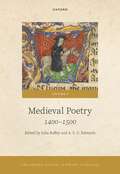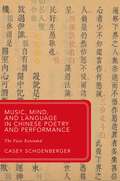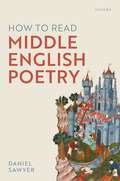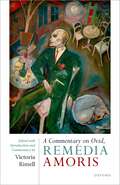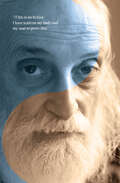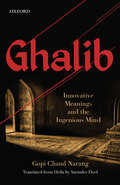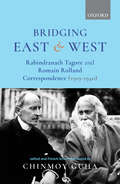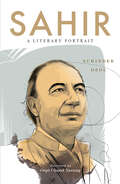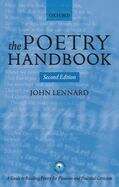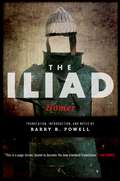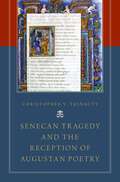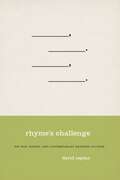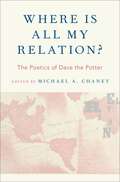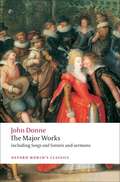- Table View
- List View
The Oxford History of Poetry in English: Volume 3. Medieval Poetry: 1400-1500 (Oxford History of Poetry in English)
The Oxford History of Poetry in English is designed to offer a fresh, multi-voiced, and comprehensive analysis of 'poetry': from Anglo-Saxon culture through contemporary British, Irish, American, and Global culture, including English, Scottish, and Welsh poetry, Anglo-American colonial and post-colonial poetry, and poetry in Canada, Australia, New Zealand, the Caribbean, India, Africa, Asia, and other international locales. The series both synthesizes existing scholarship and presents cutting-edge research, employing a global team of expert contributors for each of the fourteen volumes. This volume explores the developing range of English verse in the century after the death of Chaucer in 1400, years that saw both change and consolidation in traditions of poetic writing in English in the regions of Britain. Chaucer himself was an important shaping presence in the poetry of this period, providing a stimulus to imitation and to creative expansion of the modes he had favoured. In addition to assessing his role, this volume considers a range of literary factors significant to the poetry of the century, including verse forms, literary language, translation, and the idea of the author. It also signals features of the century's history that were important for the production of English verse: responses to wars at home and abroad, dynastic uncertainty, and movements towards religious reform, as well as technological innovations such as the introduction of printing, which brought influential changes to the transmission and reception of verse writing. The volume is shaped to include chapters on the contexts and forms of poetry in English, on the important genres of verse produced in the period, on some of the fifteenth-century's major writers (Lydgate, Hoccleve, Dunbar, and Henryson), and a consideration of the influence of the verse of this century on what was to follow.
The Oxford History of Poetry in English: Volume 3. Medieval Poetry: 1400-1500 (Oxford History of Poetry in English)
by Julia BoffeyThe Oxford History of Poetry in English is designed to offer a fresh, multi-voiced, and comprehensive analysis of 'poetry': from Anglo-Saxon culture through contemporary British, Irish, American, and Global culture, including English, Scottish, and Welsh poetry, Anglo-American colonial and post-colonial poetry, and poetry in Canada, Australia, New Zealand, the Caribbean, India, Africa, Asia, and other international locales. The series both synthesizes existing scholarship and presents cutting-edge research, employing a global team of expert contributors for each of the fourteen volumes. This volume explores the developing range of English verse in the century after the death of Chaucer in 1400, years that saw both change and consolidation in traditions of poetic writing in English in the regions of Britain. Chaucer himself was an important shaping presence in the poetry of this period, providing a stimulus to imitation and to creative expansion of the modes he had favoured. In addition to assessing his role, this volume considers a range of literary factors significant to the poetry of the century, including verse forms, literary language, translation, and the idea of the author. It also signals features of the century's history that were important for the production of English verse: responses to wars at home and abroad, dynastic uncertainty, and movements towards religious reform, as well as technological innovations such as the introduction of printing, which brought influential changes to the transmission and reception of verse writing. The volume is shaped to include chapters on the contexts and forms of poetry in English, on the important genres of verse produced in the period, on some of the fifteenth-century's major writers (Lydgate, Hoccleve, Dunbar, and Henryson), and a consideration of the influence of the verse of this century on what was to follow.
Music, Mind, and Language in Chinese Poetry and Performance: The Voice Extended (Global Asias)
by Casey Schoenberger"Poetry puts intent into words; singing lengthens words"--this is one of the earliest Chinese comments on artistic expression. Poetic language extends the reach of a sentiment beyond the individual, and musicality extends the reach of poetic language, not only across a room, but across geography and generations. The "extended mind thesis" (EMT) views minds as extending beyond individual nervous systems to include material and social environments. Music, Mind, and Language in Chinese Poetry and Performance: The Voice Extended offers a comprehensive overview of the interwoven histories of traditional Chinese poetry and performing arts. It employs cognitive and quantitative methods such as EMT, and a database of over six thousand traditional melodies, to describe cyclical, continuous interactions between social minds and material artifacts. From the ancient Canon of Poetry to the song-lyrics (ci) of the late medieval period and the dramatic arias of Kun and Beijing operas, Casey Schoenberger introduces the rhythms, melodies, pronunciation, and grammatical stylistics of the major Chinese verse and performance traditions. In doing so, he gleans insights from cognitive neuroscience, digital humanities, musicology, and linguistics to explain not only the trajectory of Chinese arts, but also bigger phenomena, like vernacularisation and improvisation.
Music, Mind, and Language in Chinese Poetry and Performance: The Voice Extended (Global Asias)
by Casey Schoenberger"Poetry puts intent into words; singing lengthens words"—this is one of the earliest Chinese comments on artistic expression. Poetic language extends the reach of a sentiment beyond the individual, and musicality extends the reach of poetic language, not only across a room, but across geography and generations. The "extended mind thesis" (EMT) views minds as extending beyond individual nervous systems to include material and social environments. Music, Mind, and Language in Chinese Poetry and Performance: The Voice Extended offers a comprehensive overview of the interwoven histories of traditional Chinese poetry and performing arts. It employs cognitive and quantitative methods such as EMT, and a database of over six thousand traditional melodies, to describe cyclical, continuous interactions between social minds and material artifacts. From the ancient Canon of Poetry to the song-lyrics (ci) of the late medieval period and the dramatic arias of Kun and Beijing operas, Casey Schoenberger introduces the rhythms, melodies, pronunciation, and grammatical stylistics of the major Chinese verse and performance traditions. In doing so, he gleans insights from cognitive neuroscience, digital humanities, musicology, and linguistics to explain not only the trajectory of Chinese arts, but also bigger phenomena, like vernacularisation and improvisation.
How to Read Middle English Poetry
by Daniel SawyerHow to Read Middle English Poetry guides readers through poetry between 1150 and 1500, for study and pleasure. Chapters give down-to-earth advice on enjoying and analyzing each aspect of verse, from the choice of single words, through syntax, metre, rhyme, and stanza-design, up to the play of larger forms across whole poems. How to Read Middle English Poetry covers major figures?such as Chaucer, Langland, the Pearl Poet, and Robert Henryson?but also delves into exciting anonymous lyrics, romances, and drama. It shows, too, how some modern poets have drawn on earlier poems, and how Middle English and early Scots provide crucial standpoints from which to think through present-day writing. Contextual sections discuss how poetry was heard aloud, introduce manuscripts and editing, and lay out Middle English poetry's ties to other tongues, including French, Welsh, and Latin. Critical terms are highlighted and explained both in the main text and in a full indexed glossary, while the uses of key tools such as the Middle English Dictionary are described and modeled. References to accessible editions and electronic resources mean that the book needs no accompanying anthology. At once thorough, wide-ranging, and practical, How to Read Middle English Poetry is indispensable for students exploring Middle English or early Scots, and for anyone curious about the heart of poetry's history.
How to Read Middle English Poetry
by Daniel SawyerHow to Read Middle English Poetry guides readers through poetry between 1150 and 1500, for study and pleasure. Chapters give down-to-earth advice on enjoying and analyzing each aspect of verse, from the choice of single words, through syntax, metre, rhyme, and stanza-design, up to the play of larger forms across whole poems. How to Read Middle English Poetry covers major figures?such as Chaucer, Langland, the Pearl Poet, and Robert Henryson?but also delves into exciting anonymous lyrics, romances, and drama. It shows, too, how some modern poets have drawn on earlier poems, and how Middle English and early Scots provide crucial standpoints from which to think through present-day writing. Contextual sections discuss how poetry was heard aloud, introduce manuscripts and editing, and lay out Middle English poetry's ties to other tongues, including French, Welsh, and Latin. Critical terms are highlighted and explained both in the main text and in a full indexed glossary, while the uses of key tools such as the Middle English Dictionary are described and modeled. References to accessible editions and electronic resources mean that the book needs no accompanying anthology. At once thorough, wide-ranging, and practical, How to Read Middle English Poetry is indispensable for students exploring Middle English or early Scots, and for anyone curious about the heart of poetry's history.
A Commentary on Ovid, Remedia Amoris: Edited with Introduction and Commentary
by Victoria RimellThe Ovidian Renaissance seems to have left the Remedia Amoris behind. The poem has remained marginal, read either as a reversal of the Ars Amatoria's teaching that brings the world of Ovidian elegy to a banal end, or as an over-determined supplement to the Ars which ironically fails in its ostensible aim of 'curing' the dissatisfied lover. While recent work has explored how the poem functions not just as a palinode to, but also as a continuation of, the Ars, the critical status quo continues to present it as a minor appendage rather than as an important chapter in Ovid's project as a poet of desire. Victoria Rimell's commentary resets critical perspectives by reading the Remedia as distinctive and original, and as a pivotal text within Ovid's oeuvre as a whole. In her immersive, creatively interpretative guide to the poem, the Remedia emerges as an intricate work that interacts with medical texts, works on rhetoric, law, magic and ritual, philosophical thinking about self-discipline, the irrational, consolation and therapy for the soul, as well as with Greco-Roman satire, lyric, epigram, and traditions of didactic and erotodidactic verse. The poem, Rimell argues, is a key node in Ovid's development of a poetics of paradox, reversibility, and auto-immunity.
Universalist Hopes in India and Europe: The Worlds of Rabindranath Tagore and Srečko Kosovel
by Ana JelnikarIn 1913, Rabindranath Tagore received the Nobel Prize in Literature. World famous overnight, he was translated into numerous languages. Meanwhile, in Slovenia, a young, still anonymous poet felt strongly drawn to the newly available works of the Indian bard. This young man was Srečko Kosovel, who is today hailed as Slovenia’s leading avant-garde poet of the interwar period. But what could Kosovel, then barely out of his teens, have in common with a figure of Tagore’s stature? Deeply affected by Italy’s conquest of parts of Slovene-populated territory, Kosovel was able to identify with Tagore and relate to the historical predicament of colonial subjugation. Despite coming from different backgrounds, they were kindred spirits a dynamic, creative ideal of universalism lay at the core of their concerns. As a ‘true’ universalist, in the sense of feeling empathy with the less fortunate, it was more in the spirit of equality that Kosovel approached Tagore. This volume is the first comparative study of the writings of these two poets who lived worlds apart but spoke in strikingly similar voices. It explores the links between India and East-Central Europe in the early decades of the twentieth century and gives expression to responses from within Europe that have largely been overlooked in postcolonial and cultural studies.
Secret Writings of Hoshang Merchant
by Akshaya K. RathNever a shrinking violet, Hoshang Merchant came out of the closet early in his youth. A bard, a teacher, and a lover who has lived many lives, he is the quintessential gay who once cross-dressed, and yet defies categorization. In Secret Writings, he recounts his extraordinary life and splendid experiences ranging across countries and cultures. His is a story of the prejudice and neglect that are part of everyday gay life, and how he channelled his despair into creating poetry. He quotes Rumi, Ghalib, and Mir, and writes with searing honesty about his long and short love affairs, his ‘improbable’ sex life as both an initiator and a yielding partner, and his inner turmoil. Sex becomes love and love becomes poetry in his writing. Merchant yells at the moral guardians of law and culture, asks uncomfortable questions, and shocks his readers. This rare book opens a window to the myriad worlds of an avant-garde.
Ghalib: Innovative Meanings and the Ingenious Mind
by Gopi Chand NarangMirza Asadullah Khan (1797–1869), popularly, Ghalib, is the most influential poet of the Urdu language. He is noted for the ghazals he wrote during his lifetime, which have since been interpreted and sung by different people in myriad ways. Ghalib’s popularity has today extended beyond the Indian subcontinent to the Hindustani diaspora around the world. In this book, Gopi Chand Narang studies Ghalib’s poetics by tracing the archetypical roots of his creative consciousness and enigmatic thought in Buddhist dialectical philosophy, particularly in the concept of shunyata. He underscores the importance of the Mughal era’s Sabke Hindi poetry, especially through Bedil, whom Ghalib considered his mentor. The author also engages with Ghalib criticism that has flourished since his death and analyses the important works of the poet, including pieces from early Nuskhas and Divan-e Ghalib, strengthening this central argument. Much has been written about Ghalib’s life and his poetry. A marked departure from this dominant trend, Narang’s book looks at Ghalib from different angles and places him in the galaxy of the great Eastern poets, stretching far beyond the boundaries of India and the Urdu language.
Bridging East and West: Rabindranath Tagore and Romain Rolland Correspondence (1919–1940)
by Chinmoy GuhaDating from 1919 to 1940, these letters and telegrams are being published for the first time in English in their entirety. They manage to capture the essence of Tagore and Rolland’s friendship in their struggle with the conflict between nationalism and human conscience. This volume also presents three important conversations the two engaged in at various points in time, as well as letters by Rathindranath Tagore and others, and lays out the journey of these two writers towards the imaging of a different world outside jingoistic politics. This correspondence presents the finest exchange of thought between the East and the West, and scripts the intellectual history of early twentieth century.
Sahir: A Literary Portrait
by Surinder DeolSahir Ludhianvi (1921–1980), a remarkable film lyricist, was also an iconic literary poet. Surinder Deol paints a sensitive portrait that reveals an artist who was aware of the depth of his poetic message as well as of his ability to present it in words that captured the reader’s imagination. Sahir looked outward at the world to find beauty in nature for inspiration while at the same time raising his voice against poverty, deprivation, and the denial of social justice. The book contains free verse translation of over ninety of Sahir’s literary creations, including poems, ghazals, bhajans, and a long peace poem called Parchhaaiyaan (The Shadows). The author strives to bring together four distinct elements of Sahir’s work that make him one of the most loved poets of our generation: his deep-rooted love of nature, his snug romanticism, his sensitivity to human suffering, and his unceasing optimism for a better tomorrow.
Reflections: The OCR Collection of Literacy Heritage and Contemporary Poetry (PDF)
by Oxford University Press'Reflections' is OCR's collection of poems designed to meet the requirements of the National Curriculum Programme of study and of the QCDA subject criteria for GCSE English, English language and English literature.
The Poetry Handbook (PDF)
by John LennardThe Poetry Handbook is a lucid and entertaining guide to the poet's craft, and an invaluable introduction to practical criticism for students. Chapters on each element of poetry, from metre to gender, offer a wide-ranging general account, and end by looking at two or three poems from a small group (including works by Donne, Elizabeth Bishop, Geoffrey Hill, and Nobel Laureate Derek Walcott), to build up sustained analytical readings. Thorough and compact, with notes and quotations supplemented by detailed reference to the Norton Anthology of Poetry and a companion website with texts, links, and further discussion, The Poetry Handbook is indispensable for all school and undergraduate students of English. A final chapter addresses examinations of all kinds, and sample essays by undergraduates are posted on the website. Critical and scholarly terms are italicised and clearly explained, both in the text and in a complete glossary; the volume also includes suggestions for further reading. The first edition, widely praised by teachers and students, showed how the pleasures of poetry are heightened by rigorous understanding and made that understanding readily available. This second edition - revised, expanded, updated, and supported by a new companion website - confirm The Poetry Handbook as the best guide to poetry available in English.
The Iliad
by Barry B. PowellThe Iliad is a riddle, wrapped in a mystery, inside an enigma, for which Barry Powell, one of the twenty-first century's leading Homeric scholars, has given us a magnificent new translation. Graceful, lucid, and energetic, Powell's translation renders the Homeric Greek with a simplicity and dignity reminiscent of the original. The text immediately engrosses students with its tight and balanced rhythms, while the incantatory repetitions evoke a continuous "stream of sound" that offers as good an impression of Homer's Greek as one could hope to attain without learning the language. Accessible, poetic, and accurate, Powell's translation is an excellent fit for today's students. With swift, transparent language that rings both ancient and modern, it exposes them to all of the rage, pleasure, pathos, and humor that are Homer's Iliad. Both the translation and the introduction are informed by the best recent scholarship. FEATURES * Uses well-modulated verse and accurate English that is contemporary but never without dignity * Powell's introduction sets the poem in its philological, mythological, and historical contexts * Features unique on-page notes, facilitating students' engagement with the poem * Embedded illustrations accompanied by extensive captions provide Greek and Roman visual sources for key passages in each of the poem's twenty-four books * Eight maps (the most of any available translation) provide geographic context for the poem's many place names * Audio recordings (read by Powell) of fifteen important passages are available at www.oup.com/us/powell and indicated in the text margin by an icon
The Iliad: Literally Translated, With Explanatory Notes (classic Reprint)
by HomerThe Iliad is a riddle, wrapped in a mystery, inside an enigma, for which Barry Powell, one of the twenty-first century's leading Homeric scholars, has given us a magnificent new translation. Graceful, lucid, and energetic, Powell's translation renders the Homeric Greek with a simplicity and dignity reminiscent of the original. The text immediately engrosses students with its tight and balanced rhythms, while the incantatory repetitions evoke a continuous "stream of sound" that offers as good an impression of Homer's Greek as one could hope to attain without learning the language. Accessible, poetic, and accurate, Powell's translation is an excellent fit for today's students. With swift, transparent language that rings both ancient and modern, it exposes them to all of the rage, pleasure, pathos, and humor that are Homer's Iliad. Both the translation and the introduction are informed by the best recent scholarship. FEATURES * Uses well-modulated verse and accurate English that is contemporary but never without dignity * Powell's introduction sets the poem in its philological, mythological, and historical contexts * Features unique on-page notes, facilitating students' engagement with the poem * Embedded illustrations accompanied by extensive captions provide Greek and Roman visual sources for key passages in each of the poem's twenty-four books * Eight maps (the most of any available translation) provide geographic context for the poem's many place names * Audio recordings (read by Powell) of fifteen important passages are available at www.oup.com/us/powell and indicated in the text margin by an icon
Senecan Tragedy and the Reception of Augustan Poetry
by Christopher V. TrinactyIn their practice of aemulatio, the mimicry of older models of writing, the Augustan poets often looked to the Greeks: Horace drew inspiration from the lyric poets, Virgil from Homer, and Ovid from Hesiod, Callimachus, and others. But by the time of the great Roman tragedian Seneca, the Augustan poets had supplanted the Greeks as the "classics" to which Seneca and his contemporaries referred. Indeed, Augustan poetry is a reservoir of language, motif, and thought for Seneca's writing. Strangely, however, there has not yet been a comprehensive study revealing the relationship between Seneca and his Augustan predecessors. Christopher Trinacty's Senecan Tragedy and the Reception of Augustan Poetry is the long-awaited answer to the call for such a study. Senecan Tragedy and the Reception of Augustan Poetry uniquely places Senecan tragedy in its Roman literary context, offering a further dimension to the motivations and meaning behind Seneca's writings. By reading Senecan tragedy through an intertextual lens, Trinacty reveals Seneca's awareness of his historical moment, in which the Augustan period was eroding steadily around him. Seneca, looking back to the poetry of Horace, Virgil, and Ovid, acts as a critical interpreter of both their work and their era. He deconstructs the language of the Augustan poets, refiguring it through the perspective of his tragic protagonists. In doing so, he positions himself as a critic of the Augustan tradition and reveals a poetic voice that often subverts the classical ethos of that tradition. Through this process of reappropriation Seneca reveals much about himself as a playwright and as a man: In the inventive manner in which he re-employs the Augustan poets' language, thought, and poetics within the tragic framework, Seneca gives his model works new--and uniquely Senecan--life. Trinacty's analysis sheds new light both on Seneca and on his Augustan predecessors. As such, Senecan Tragedy and the Reception of Augustan Poetry promises to be a groundbreaking contribution to the study of both Senecan tragedy and Augustan poetry.
Rhyme's Challenge: Hip Hop, Poetry, and Contemporary Rhyming Culture
by David CaplanRhyme's Challenge offers a concise, pithy primer to hip-hop poetics while presenting a spirited defense of rhyme in contemporary American poetry. David Caplan's stylish study examines hip-hop's central but supposedly outmoded verbal technique: rhyme. At a time when print-based poets generally dismiss formal rhyme as old-fashioned and bookish, hip-hop artists deftly deploy it as a way to capture the contemporary moment. Rhyme accommodates and colorfully chronicles the most conspicuous conditions and symbols of contemporary society: its products, technologies, and personalities. Ranging from Shakespeare and Wordsworth to Eminem and Jay-Z, David Caplan's study demonstrates the continuing relevance of rhyme to poetry -- and everyday life.
Containing Multitudes: Walt Whitman and the British Literary Tradition
by Gary SchmidgallWalt Whitman burst onto the literary stage raring for a fight with his transatlantic forebears. With the unmetered and unrhymed long lines of Leaves of Grass, he blithely forsook "the old models" declaring that "poems distilled from other poems will probably pass away." In a self-authored but unsigned review of the inaugural 1855 edition, Whitman boasted that its influence-free author "makes no allusions to books or writers; their spirits do not seem to have touched him." There was more than a hint here of a party-crasher's bravado or a new-comer's anxiety about being perceived as derivative. But the giants of British literature were too well established in America to be toppled by Whitman's patronizing "that wonderful little island," he called England-or his frequent assertions that Old World literature was non grata on American soil. As Gary Schmidgall demonstrates, the American bard's manuscripts, letters, prose criticism, and private conversations all reveal that Whitman's negotiation with the literary "big fellows" across the Atlantic was much more nuanced and contradictory than might be supposed. His hostile posture also changed over the decades as the gymnastic rebel transformed into Good Gray Poet, though even late in life he could still crow that his masterwork Leaves of Grass "is an iconoclasm, it starts out to shatter the idols of porcelain." Containing Multitudes explores Whitman's often uneasy embrace of five members of the British literary pantheon: Shakespeare, Milton, Burns, Blake, and Wordsworth (five others are treated more briefly: Scott, Carlyle, Tennyson, Wilde, and Swinburne). It also considers how the arcs of their creative careers are often similar to the arc of Whitman's own fifty years of poem-making. Finally, it seeks to illuminate the sometimes striking affinities between the views of these authors and Whitman on human nature and society. Though he was loath to admit it, these authors anticipated much that we now see as quintessentially Whitmanic.
Where Is All My Relation?: The Poetics of Dave the Potter
Where Is All My Relation? presents the first sustained academic discussion of the poetry, pottery, and culture of David Drake, an antebellum slave who distinguished himself by composing verse on the ceramics he produced in the years leading up to the Civil War. During the 1830s, 40s, and 50s, he incised couplets and signatures (a singular "Dave") onto the incredibly large storage vessels that he made. In fact, his stoneware pots and jars are among the largest made in North America during the antebellum era, and craft enthusiasts and appraisers are still proclaiming their precision and ambitious volume. Rich with biblical allusions, historical facts, and personal opinions, his art provides unique insights into the lives of slaves, craftsmen, and the culture of the American South in the first half of the nineteenth century. The essays here engage with the historical context and major issues that Drake's work provokes, among them: prohibitions against slave literacy; Drake's privileged status compared to other slaves at the time; the interpretive status of his material craft objects; the influence of contemporary African American poet George Moses Horton; and Drake's ability to sell his pottery despite the fact that slaves were not officially permitted to participate in a cash economy. Featuring essays by literary critics, art-historians, archaeologists, and curators, Where Is All My Relation? provides a window into the world of nineteenth century material culture and expands our traditional understanding of the slave-narrative genre.
John Donne - The Major Works - Oxford World's Classics: 400MB file
by John Donne John CareyThis authoritative edition was formerly published in the acclaimed Oxford Authors series under the general editorship of Frank Kermode. It brings together a unique combination of Donne's poetry and prose - all the major poems, complemented by rarely published letters and extracts from Donne's sermons - to give the essence of his work and thinking. John Donne (1572-1631) is today celebrated as one of the greatest of the metaphysical poets, whose verse was daringly original and whose use of imagery and conceits marked a new, intellectual approach to poetry. His Satires, Elegies, and Songs and Sonnets, which contain his most famous love poems, were complemented by his religious writing, both verse and prose. He was one of the most renowned preachers of his day, and this volume does equal justice to the full range of his work. In addition to nearly all his English poetry this volume includes over 130 extracts from Donne's sermons, as well as the full text of his last sermon, 'Death's Duel'. A distinguishing feature of the selection is that the works are arranged in the chronological order of their composition. ABOUT THE SERIES: For over 100 years Oxford World's Classics has made available the widest range of literature from around the globe. Each affordable volume reflects Oxford's commitment to scholarship, providing the most accurate text plus a wealth of other valuable features, including expert introductions by leading authorities, helpful notes to clarify the text, up-to-date bibliographies for further study, and much more.
Sir Philip Sidney: The Major Works (Oxford World's Classics Ser.)
by Philip Sidney Katherine Duncan-JonesBorn in 1554, Sir Philip Sidney was hailed as the perfect Renaissance patron, soldier, soldier, lover, and courtier, but it was only after his untimely death at the age of thirty-two that his literary achievements were truly recognized. This collection includes supplementary texts, such as his letters and the numerous elegies which appeared after his death, help illustrate the wide spectrum of his achievements, and the admiration he inspired in his contemporaries.
